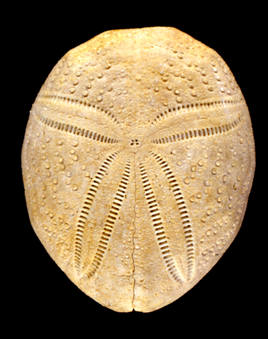......
set: fossils // series: ECHINOIDS // picture: EUPATAGUS
Echinoids (sea urchins) first appeared in the early Palaeozoic, and became common fossils from the Jurassic onwards, during the last 200 million years. Eupatagus, illustrated here (length 60 mm), is a genus of Cenozoic age, so locally common in sedimentary rocks (especially limestones) deposited within the very last 65 million years.
Echinoids have a particularly good fossil record which clearly reveals patterns of evolutionary adaptation and diversification, aspects which are studied in both introductory and advanced course units in palaeontology in this Department.
Teaching by Dr E.P.F. Rose draws on his own research enthusiasm in the fields of echinoid evolution, biostratigraphy and palaeobiogeography. (See for example: Rose, E.P.F. & Cross, N.E. 1993 The Chalk sea urchin Micraster: microevolution, adaptation and predation. Geology Today, vol. 9, pp. 179-186.)